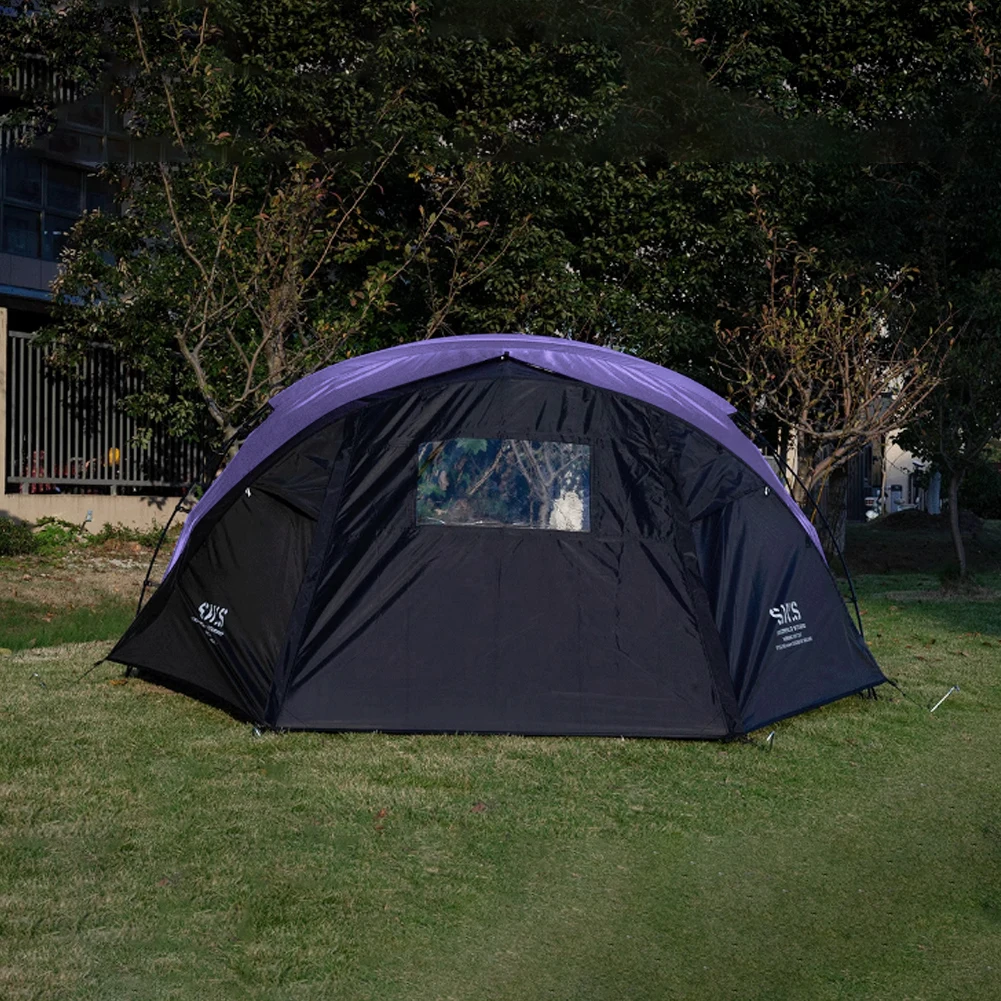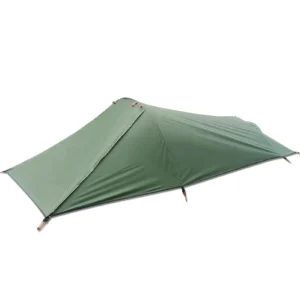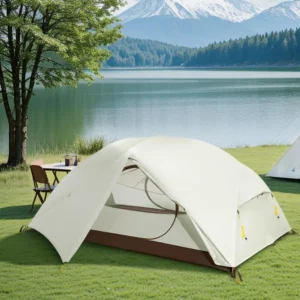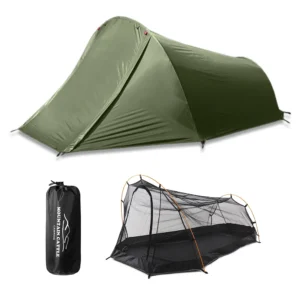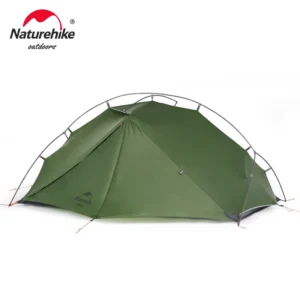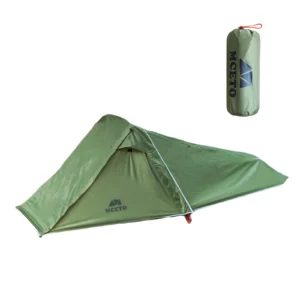The Significance of Tent Weight for Extended Wilderness Journeys
When embarking on a long-distance trek, every item in your backpack becomes your constant companion. Among these items, your tent often represents one of the bulkiest and heaviest pieces of gear you’ll carry. For those venturing on extended journeys like the Appalachian Trail or Pacific Crest Trail—where hikers might spend weeks or even months on the trail—the weight of this essential shelter becomes increasingly significant with each passing mile.
The fundamental challenge of long-distance backpacking lies in its self-sufficient nature: you must carry everything you need to survive comfortably for extended periods. In this context, tent weight emerges as one of the most critical factors affecting your overall trekking experience, physical wellbeing, and ultimately, your success in completing ambitious routes.
Understanding different shelter options for two campers becomes essential when planning extended wilderness journeys. The weight of your tent directly influences your energy levels, hiking pace, and even your mood throughout your adventure. As we’ll explore in this article, the significance of tent weight extends far beyond simply reducing pack weight—it fundamentally shapes how you experience the trail and can be the difference between an enjoyable journey and a grueling ordeal.
The relationship between tent weight and overall backpacking essential gear creates a delicate balance that every serious hiker must carefully consider before setting out on any long-distance adventure.
The Compounding Effect: Why Every Ounce Matters Over Long Distances
The mathematics of weight over distance tells a compelling story that many novice trekkers overlook. On a long-distance hike, you don’t just carry your tent once—you lift it with every single step. Consider this: an average hiker takes approximately 2,000 steps per mile. On a 15-mile day, that’s 30,000 steps. Now multiply that by a 10-day trek, and you’re looking at 300,000 individual lifting actions.
This “step penalty” concept reveals why seemingly small weight differences matter enormously. Let’s compare carrying a 4-pound (1.8 kg) traditional tent versus a 2-pound (0.9 kg) lightweight alternative:
- With the 4-pound tent: You’re lifting an extra 1,200,000 pounds cumulatively over that 10-day journey
- With the 2-pound tent: The cumulative weight lifted is reduced by 600,000 pounds
The energy expenditure difference is equally significant. Carrying extra weight requires more calories—approximately 5-10 additional calories burned per mile for each pound carried. Over hundreds of miles, this translates to thousands of extra calories needed, calories that must be either carried (adding more weight) or foraged (requiring more time and energy).
Furthermore, tent weight affects your entire pack’s balance and weight distribution. A heavier tent often creates pressure points and can pull your center of gravity backward or to one side, forcing your body to constantly compensate. The impact of tent weight on hiking endurance becomes increasingly apparent as miles accumulate, creating a compounding effect that transforms a seemingly minor weight difference into a major factor in your trekking experience.
Physical Impact: How Tent Weight Affects Your Body on the Trail
Joint Stress and Strain
Carrying excessive pack weight—including a heavier tent—places tremendous pressure on your body’s weight-bearing joints. Your knees, ankles, hips, and lower back absorb this additional force with each step. Research indicates that each additional pound in your pack increases the force on your knees by 4-5 pounds when descending, significantly accelerating joint wear over long distances. The benefits of lightweight tents for extended hikes become evident as hikers experience noticeably reduced joint pain and inflammation.
Muscular Fatigue and Recovery
Your body’s muscles work overtime to stabilize and carry heavy loads. With a heavier tent, your shoulders, back, and core muscles face constant tension, leading to faster fatigue and longer recovery times. This is particularly important on multi-day treks, where incomplete recovery compounds day after day, potentially leading to a performance decline known as “hiker breakdown”—a state where the body can no longer fully recover overnight.
Injury Risk and Stability
Additional weight increases both the likelihood and severity of common hiking injuries. A heavier load affects your balance, particularly on technical terrain like rock scrambles, exposed ridges, or river crossings. This balance impairment increases fall risk and severity, especially when fatigue sets in during late-day hiking. Moreover, the extra weight contributes to higher rates of overuse injuries such as tendonitis and stress fractures, which can abruptly end a long-distance journey.
Foot Problems and Blisters
The increased pressure on your feet from carrying heavier gear translates directly to more friction, heat, and moisture—the perfect recipe for serious blister development. While seemingly minor, blisters are among the most common reasons hikers abandon long treks prematurely. Each additional ounce in your pack increases the downward pressure on your feet, magnifying this risk substantially with each mile.
Performance Implications: Distance, Speed, and Daily Mileage
The relationship between pack weight and hiking performance is direct and measurable. Field studies consistently show that hikers carrying lighter loads maintain faster average speeds throughout the day. For example, a hiker with a 25-pound (11.3 kg) pack typically covers 15-20% more ground than someone carrying 40 pounds (18.1 kg), assuming similar fitness levels.
This performance gap becomes especially evident when considering daily mileage capabilities. A lightweight setup featuring ultralight tent features for thru-hiking might enable hiking days of 15-20 miles comfortably, while heavier setups often limit hikers to 10-12 miles before fatigue becomes problematic. Over a month-long trek, this difference can mean completing an additional 150 miles or finishing your journey 1-2 weeks earlier.
The performance implications extend beyond flat terrain. When encountering challenging sections like steep ascents, high-altitude passes, or off-trail navigation, the energy conservation from carrying a lighter tent becomes even more valuable. Hikers with lighter packs typically maintain better decision-making capabilities during these technically demanding sections because they’re less physically exhausted.
For trip planning purposes, these performance differences dramatically affect itinerary possibilities. With a lighter tent, hikers can realistically plan more ambitious routes, include optional side trips to scenic viewpoints, or build in flexibility for weather delays without jeopardizing their overall schedule. The compound effect of improved daily performance transforms the entire trekking experience from a grueling endurance event into a more enjoyable journey.
Tent Weight and Its Psychological Effects During Long Treks
The psychological burden of carrying excessive weight is often underestimated but profoundly important. Many long-distance hikers report that the mental fatigue from struggling with a heavy pack can be more debilitating than the physical strain itself. A lighter tent contributes significantly to overall pack weight reduction, creating what experienced hikers often describe as a psychological “lightness” that extends beyond the physical.
“The difference between my first thru-hike with a 5-pound tent and my second with a 2-pound shelter wasn’t just physical—it completely changed my mental state on trail. With the lighter setup, I stopped dreading each day’s climb and started actually looking up to enjoy the views,” reports one Continental Divide Trail veteran.
Physical discomfort from heavy loads directly impacts mood, enthusiasm, and overall enjoyment. Hikers carrying lighter tents typically report better trail experiences, more positive journal entries, and greater appreciation of their surroundings. Conversely, those overburdened with heavy gear often focus narrowly on putting one foot in front of another, missing the very experiences they came to enjoy.
There’s also a significant confidence factor in play. Hikers carrying lightweight gear approach challenging trail sections—steep ascents, difficult terrain, or long waterless stretches—with greater assurance in their abilities to safely navigate these obstacles. Mastering lightweight tent setup techniques further enhances this psychological advantage by reducing camp chores and conserving mental energy.
Understanding Tent Weight Classifications for Long-Distance Hiking
To make informed decisions about tent weight, it’s helpful to understand how backpacking tents are categorized by weight. Different classifications serve different purposes and come with their own advantages and limitations:
| Weight Category | Weight Range | Best Applications | Key Characteristics |
|---|---|---|---|
| Ultralight | Under 2 lbs (0.9 kg) | Thru-hiking, long-distance treks | Minimal features, often single-wall, may use trekking poles |
| Lightweight | 2-3 lbs (0.9-1.4 kg) | Backpacking trips of multiple days | Good balance of weight and features |
| Standard | 3-5 lbs (1.4-2.3 kg) | Weekend trips, mixed conditions | More durable materials, extra features, typically freestanding |
| Expedition/Heavy | 5+ lbs (2.3+ kg) | Base camping, extreme weather | Maximum durability and weather protection, multiple features |
When evaluating tent specifications, it’s crucial to understand the different weight measurements provided by manufacturers:
- Minimum Trail Weight: Includes only the tent body, rainfly, and poles—the minimum needed to set up the tent
- Packaged Weight: Includes everything that comes with the tent (stakes, guy lines, stuff sacks, repair kit)
- Actual Trail Weight: What most hikers actually carry, typically between the above two figures
For long-distance treks, most experienced hikers aim for tents in the ultralight to lightweight categories. A comprehensive guide to ultralight and lightweight tents can help you better understand the specific features and tradeoffs in each category. The growing collection of ultralight 2-person tents shows how manufacturers are continually innovating to reduce weight while maintaining functionality.

The Weight-Durability Balance: Making Smart Tradeoffs
Finding the right balance between weight reduction and durability represents one of the most crucial decisions in tent selection. Lighter isn’t always better if it means compromising the shelter’s ability to withstand your expected conditions.
Material Considerations
Fabric Choices:
– Silnylon (Silicone-coated nylon): Moderate weight (1.1-1.5 oz/yd²), good durability, moderate cost
– DCF/Dyneema (formerly Cuben Fiber): Extremely lightweight (0.5-0.8 oz/yd²), excellent strength-to-weight ratio, very high cost
– Polyester: Slightly heavier than nylon, better UV resistance, less stretching when wet, lower cost
Pole Materials:
– Aluminum: Good balance of weight, strength, and affordability
– Carbon Fiber: Extremely lightweight, less durable, more expensive
– Composite: Modern blended materials offering weight savings with reinforced durability points
Environmental Conditions
Your expected conditions should heavily influence your weight-durability decisions. For routes through dense forests with potential branch fall, more durable fabrics may justify extra weight. For open alpine terrain where wind exposure is the primary concern, structural strength becomes more important than fabric thickness.
Long-term Value Assessment
While ultralight tents often carry premium price tags, their value proposition improves when calculated on a per-mile basis for long treks. A slightly more expensive but significantly lighter tent might prove more economical when considering the reduced physical toll and increased enjoyment over thousands of miles.
Many lightweight backpacking tent options strike an effective balance between weight reduction and material durability, offering the best value for most long-distance hikers who don’t want to replace their shelter after a single season.
Weather Resistance vs. Weight: Finding Your Sweet Spot
Weather protection represents another critical area where weight considerations must be balanced against functionality. Long-distance treks typically expose hikers to a wide range of conditions, sometimes requiring shelters to withstand everything from desert heat to mountain storms.
Critical Weather Protection Features
- Complete Rainfly Coverage: Full-coverage rainflies offer superior protection but add weight compared to partial coverage designs
- Vestibule Space: Essential for gear storage and cooking in poor weather, but additional vestibule area adds ounces
- Bathtub Floor Height: Higher bathtub floors provide better protection against ground water but require more material
- Ventilation Systems: Critical for condensation management but often require additional design elements and weight
Seasonality Considerations
Most long-distance hikers select 3-season tents to optimize weight savings. However, if your trek involves potential snow or high-wind exposure at elevation, the additional weight of a more robust design may be justified. The key is matching your tent’s capabilities to the most challenging conditions you’re likely to encounter, not the average conditions.
Modern waterproof backpacking tent designs have become increasingly sophisticated in their ability to provide reliable weather protection while maintaining reasonable weight profiles. The best designs strategically distribute material where it matters most for weather resistance while trimming ounces elsewhere.
Space and Comfort Considerations for Extended Time on Trail
When you’re spending weeks or months living in your tent, interior space and comfort features take on heightened importance. The right balance between space and weight becomes particularly crucial:
Critical Comfort Features and Their Weight Implications
- Interior Height: Each additional inch of headroom adds weight but dramatically improves livability
- Floor Dimensions: Width and length directly correlate to material weight but determine sleeping comfort
- Door Configuration: Two doors improve access and ventilation but add weight through additional zippers and material
- Interior Organization: Pockets and gear lofts add minimal weight but significantly enhance livability
Long-term Livability Factors
On longer trips, you’re likely to spend more time in your tent due to weather days, rest days, or simply longer evenings in camp. Features that seem like luxuries on weekend trips become necessities when your tent is your home for months. The psychological benefit of having adequate living space cannot be overstated during extended journeys.
Understanding what size tent works best for two people helps strike the right balance between comfort and weight. For solo hikers, a two-person tent might seem extravagant, but the additional space-to-weight ratio often justifies the modest weight increase, especially on longer journeys when comfort becomes paramount.
Lightweight Backpacking Tent, Ultralight Backpacking Tent, Ultralight Bivy Tent
Ultralight Single Person Camping Tent with Aluminum Poles for 3-Season Backpacking Waterproof DesignPrice range: $94.88 through $326.82 Select options This product has multiple variants. The options may be chosen on the product pageLightweight Backpacking Tent, Ultralight Backpacking Tent, Waterproof Backpacking Tent
$391.05 Select options This product has multiple variants. The options may be chosen on the product pageCompact Backpacking Tent, Lightweight Backpacking Tent, Waterproof Camping Tent
$335.52 Select options This product has multiple variants. The options may be chosen on the product pageUltralight Backpacking Tent, Ultralight Dome Tent, Winter Camping Tent
Price range: $369.63 through $370.07 Select options This product has multiple variants. The options may be chosen on the product pageHeavy Duty 4 Season Tent, Ultralight Freestanding Tent, Winter Camping Tent
$3,722.66 Select options This product has multiple variants. The options may be chosen on the product pageBackpacking Tent with Vestibule, Freestanding Backpacking Tent, Lightweight Backpacking Tent
Price range: $446.89 through $447.22 Select options This product has multiple variants. The options may be chosen on the product page
Strategic Ways to Reduce Tent Weight Without Sacrificing Performance
Reducing tent weight doesn’t always require purchasing an expensive ultralight model. Consider these proven strategies to lighten your existing shelter:
Share the Load with Partners: When hiking with companions, divide tent components between packs. One person carries poles and stakes while another takes the fly and body, equalizing weight distribution.
Utilize Trekking Poles as Supports: Trekking pole tents eliminate the need for dedicated tent poles, potentially saving 8-14 ounces (227-397g). These designs use the trekking poles you’re already carrying for dual-purpose functionality.
Customize Your Setup Seasonally: In reliable weather, consider leaving the inner tent body behind and using just the rainfly with a groundsheet, potentially saving 30-40% of your tent weight.
Evaluate Alternative Shelter Systems: Ultralight tarps, bivy sacks, or hammock systems might better suit your needs with significant weight savings. Each alternative has specific advantages for different environments.
Upgrade Components Selectively: Rather than replacing your entire tent, consider upgrading just the heaviest components like poles or stakes. Replacing aluminum poles with carbon fiber or heavy stakes with titanium versions can save several ounces for minimal cost.
Minimize Accessories: Critically assess stuff sacks, extra stakes, and repair kits. Streamline these accessories while maintaining functionality.
The collection of trekking pole backpacking tents demonstrates how innovative designs can dramatically reduce carried weight by eliminating redundant components and leveraging gear you already carry.

How to Assess If Your Current Tent is Appropriate for Long-Distance Trekking
Is your current tent suitable for your upcoming long-distance adventure? Use this assessment framework to evaluate its appropriateness:
Weight Evaluation Checklist
- What percentage of your base weight does your tent represent? (Target: under 15%)
- How does your tent compare to modern standards for its category? (Use the good weight for ultralight tents as a benchmark)
- Is the weight-to-protection ratio appropriate for your intended terrain and conditions?
Comfort and Usability Questions
- Can you comfortably sit up inside your tent?
- Does the tent provide adequate space for you and your gear during extended weather delays?
- How quickly and easily can you set up the tent when exhausted?
- Is ventilation adequate to prevent condensation in varied conditions?
Durability Assessment
- Has your tent withstood conditions similar to those expected on your trek?
- Are there signs of wear that might become critical failures during a long journey?
- Are repair options feasible in the field if something breaks?
Making the Final Decision
If your current tent exceeds 20% of your base weight, struggles with expected conditions, or shows signs of significant wear, it may be worth considering an upgrade before embarking on a long-distance trek. However, if it falls within reasonable weight parameters and has proven reliable in similar conditions, the familiarity with your current shelter might outweigh the benefits of switching to something new and untested.
Are Ultralight Tents Worth the Investment for Long Treks?
The premium pricing of ultralight tents—often $300-600 compared to $150-250 for conventional models—raises valid questions about their value proposition. For long-distance trekkers, this cost-benefit analysis includes several key considerations:
The energy conservation and reduced physical strain over hundreds of miles often justify the higher initial investment for serious hikers. Many experienced trekkers report that their ultralight trekking pole tent “paid for itself” in increased enjoyment and reduced fatigue within the first major expedition.
However, ultralight options make the most sense for those committed to multiple extended trips or a single very long journey. For occasional weekend backpackers, the premium cost might be harder to justify against the limited usage.
Budget-conscious hikers should consider previous-generation lightweight tents (often discounted) or focus on other weight-saving measures if the ultralight premium exceeds their budget.
How Does Tent Weight Compare to Other Gear Weight Considerations?
Understanding tent weight within the context of your entire pack provides important perspective. Your shelter represents one element of the “big three”—tent, sleeping system, and backpack—which typically constitute about 60-70% of your base weight.
Within this triad, tents often offer the most significant weight-saving opportunities. While sleeping bags and backpacks have similar weight ranges, tent weights vary more dramatically between conventional and ultralight options, sometimes differing by 3-4 pounds (1.4-1.8 kg).
The most effective approach treats weight reduction systematically rather than focusing exclusively on any single item. After optimizing your shelter, similar attention to sleep systems, cooking equipment, and clothing often yields comparable cumulative benefits.
When Might a Heavier Tent Be the Right Choice?
While this article emphasizes the benefits of lighter tents for long-distance trekking, specific scenarios may justify carrying additional shelter weight:
Extreme weather expeditions where survival depends on bomb-proof shelter construction often require heavier materials and designs. When facing potential snowloads or sustained high winds, the additional security of a robust tent outweighs the carrying penalty.
Base camp oriented trips, where you establish a central camp and take day hikes, reduce the impact of tent weight since you’re not carrying it daily. In these situations, comfort features might justifiably take precedence over weight considerations.
Group or family backpacking often benefits from slightly heavier designs that offer more interior space and durability to accommodate multiple users and higher activity levels inside the tent.
The ultimate determination should balance weight concerns against your specific priorities, conditions, and comfort requirements for your unique adventure. At Explore Elements, we believe finding this perfect balance transforms good trips into extraordinary journeys.

